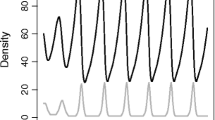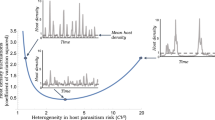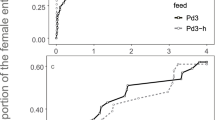Summary
The behavioural decisions of insect parasitoids have been the subject of dynamic state variable models, which explicitly incorporate the physiological state of the parasitoid, e.g. her age and ‘egg load’ (number of mature eggs). Such models have been most recently applied to parasitoid ‘host feeding’, the consumption of host body fluids or tissues by the adult female wasp. The models developed to date, and recent empirical work withAphytis melinus, have highlighted the importance of the physiology associated with host feeding to the behavioural decision whether to host feed or oviposit. Below, I develop a new dynamic state variable model which incorporates the physiological features associated with host feeding inAphytis. My intention is to make qualitative predictions about the effects of various physiological featues on host-feeding behaviour and to make quantitative predictions about the relationship between egg load and host feeding inAphytis.
Similar content being viewed by others
References
Bai, B. and Smith, S.M. (1993) Effect of host availability on reproduction and survival of the parasitoidTrichogramma minutum.Ecol. Entomol. 18, 279–86.
Bartlett, B.R. (1964) Patterns in the host feeding habit of adult parasite Hymenoptera.Ann. Entomol. Soc. Am. 57, 344–50.
Chan, M.S. (1991) Host-feeding in parasitic wasps: a study of population patterns generated by individual behavior. Unpublished PhD thesis, University of London, London, UK.
Chan, M.S. and Godfray, H.C.J. (1993) Host-feeding strategies in parasitoid wasps.Evol. Ecol. 7, 593–604.
Clark, C.W. (1987) The lazy, adaptable lions: a Markovian model of group foraging.Anim. Behav. 35, 361–8.
Clark, C.W. (1992) Dynamic models of behavior: an extension of life history theory.Trends Ecol. Evol. 8, 205–9.
Clark, C.W. and Ydenburg, R.C. (1990a) The risks of parenthood. I. General theory and applications.Evol. Ecol. 4, 21–34.
Clark, C.W. and Ydenburg, R.C. (1990b) The risks of parenthood. II. Parent—offspring conflict.Evol. Ecol. 4, 312–25.
Collier, T.R., Murdoch, W.W. and Nisbet, R.M. (1994) Egg load and the decision to host-feed in the parasitoid,Aphytis melinus.J. Anim. Ecol. 63, 299–306.
Collier, T.R. (1995) Host feeding, egg maturation, resorption and longevity in the parasitoid,Aphytis melinus (Hymenoptera; Aphelinidae).Ann. Entomol. Soc. Am. (in press).
Flanders, S.E. (1935) An apparent correlation between the feeding habits of certain pteromalids and the condition of their ovarian follicles.Annals Entomol. Soc. Am. 28, 438–44.
Flanders, S.E. (1942) Oosorption and ovulation in relation to oviposition in the parasitic hymenoptera.Annals Entomol. Soc. Am. 35, 251–6.
Friedman, S. (1985) Intermediary metabolism. InFundamentals of insect physiology (M.S. Blum, ed.), pp. 467–506. John Wiley and Sons, New York.
Houston, A., Clark, C., McNamara J. and Mangel, M. (1988) Dynamic models in behavioural and evolutionary ecology.Nature 332, 29–34.
Houston, A.I., McNamara, J.M. and Godfray, H.M.C. (1992) The effect of variability on host-feeding and reproductive success in parasitoids.Bull. Math. Biol. 54, 465–76.
Ikawa, T. and Suzuki, Y. (1982) Ovipositional experience of the gregarious parasitoid,Apanteles glomeratus (Hymenoptera: Braconidae), influencing her discrimination of the host larvae,Pieris rapae crucivora.Appl. Entomol. Zool. 17(1, 119–26.
Iwasa, Y., Suzuki, Y. and Matsuda, H. (1984) Theory of oviposition strategy of parasitoids. I. Effect of mortality and limited egg number.Theor. Pop. Biol. 26, 205–27.
Jervis, M.A. and Kidd, N.A.C. (1986) Host feeding strategies in Hymenopteran parasitoids.Biol. Rev. 61, 395–434.
Kelly, E.J. and Kennedy, P.L. (1993) A dynamic state variable model of mate desertion in Coopers Hawks.Ecology 74, 351–66.
Kidd, N.A.C. and Jervis, M.A. (1989) The effects of host-feeding behaviour on the dynamics of parasitoid—host interactions, and the implications for biological control.Res. Pop. Ecol. 31, 235–74.
Leius, K (1961a) Influence of food on fecundity and longevity of adults ofItoplectis conquisitor (Say) (Hymenoptera: Ichneumonidae).Can. Entomol. 93, 771–80.
Leius, K. (1961b) Influence of various foods on fecundity and longevity of adults ofScambus buolianae (Htg.) (Hymenoptera: Ichneumonidae).Can. Entomol. 93, 1079–84.
Lucas, J.R. and Walter, L.R. (1991) When should chickadees hoard food? Theory and experimental results.Anim. Behav. 41, 579–601.
McNamara, J.M., Mace, R.H. and Houston, A.I. (1987) Optimal daily routines of singing and foraging in a bird singing to attract a mate.Behav. Ecol. Sociobiol. 20, 399–405.
Mangel, M. (1987) Oviposition site selection and clutch size in insects.J. Math. Biol. 25, 1–22.
Mangel, M. (1989a) An evolutionary interpretation of the ‘motivation to oviposit’.J. Evol. Biol. 2, 157–72.
Mangel, M. (1989b) Evolution of host selection in parasitoids: does the state of the parasitoid matter?Am. Nat. 133, 688–705.
Mangel, M. and Clark, C.W. (1986) Towards a unified foraging theory.Ecology 67, 1127–38.
Mangel, M. and Clark, C.W. (1988)Dynamic Modeling in Behavioral Ecology. Princeton University Press, Princeton, NJ.
Mangel, M. and Ludwig, D. (1992) Definition and evaluation of the fitness of behavioral programs.Ann. Rev. Ecol. Syst. 23, 507–36.
Mangel, M. and Roitberg, B.D. (1989) Dynamic information and host acceptance by a tephritid fruit fly.Ecol. Entomol. 14, 181–9.
Minkenberg, O.P.J.M., Tatar, M. and Rosenheim, J.A. (1992) Egg load as a major source of variability in insect foraging and oviposition.Oikos 65, 134–42.
Odendaal, F.J. and Rausher, M.D. (1990) Egg load influences search intensity, host selectivity and clutch size inBattus philenor butterflies.J. Insect Behav. 3, 183–93.
Pianka, E.R. (1978)Evolutionary Ecology. Harper and Row, New York.
Pilson, D. and Rausher, M.D. (1988) Clutch size adjustment by a swallowtail butterfly.Nature 333, 361–3.
Price, K. (1992) Territorial bequeathal by red squirrel mothers: a dynamic model.Bull. Math. Biol. 54, 335–54.
Pyke, G.H. (1984) Optimal foraging theory: a critical review.Ann. Rev. Ecol. Syst. 15, 523–75.
Roitberg, B.D. and Friend, W.G. (1992) A general theory for host seeking in mosquitoes.Bull. Math. Biol. 54, 401–12.
Roitberg, B.D., Mangel, M., Lalonde, R.G., Roitberg, C.A., van Alphen, J.J.M. and Vet, L. (1992) Seasonal dynamic shifts in patch exploitation by parasitic wasps.Behav. Ecol. 3, 156–65.
Roitberg, B.D., Sircom, J., Roitberg C.A., van Alphen, J.J.M. and Mangel, M. (1993). Life expectancy and reproduction.Nature 364, 108.
Rosenheim, J.A. and Rosen, D. (1991) Foraging and oviposition decisions in the parasitoidAphytis lingnanensis: distinguishing the influences of egg load and experience.J. Anim. Ecol. 60, 873–93.
Sahragard, A., Jervis, M.A. and Kidd, N.A.C. (1991) Influence of host availability on rates of oviposition and host-feeding, and on longevity inDicondylus indianus Olmi (Hymenoptera: Dryinidae), a parasitoid of the Rice Brown Planthopper,Nilaparvata lugens Stal (Hemiptera; Delphacidae).J. Appl. Entomol. 112(2, 153–62.
Singer, M.C. (1982) Quantification of host preference by manipulation of oviposition behavior in the butterflyEuphydryas editha.Oecologia 52, 224–9.
Stearns, S.C. (1976) Life-history tactics: a review of the ideas.Q. Rev. Biol. 51, 3–47.
Stearns, S.C. (1992)The evolution of life histories. Oxford University Press, Oxford.
Stephens, D.W. and Krebs, J.R. (1986)Foraging Theory. Princeton University Press, Princeton, NJ.
van Alphen, J.J.M., van Dijken, M. and Waage, J. (1987) A functional approach to superparasitism: host discrimination needs not be learnt.Netherlands J. Zool. 37, 167–79.
van Lenteren, J.C., van Vianen, A., Gast, H.F. and Kortenhoff, A. (1987) The parasite—host relationship betweenEncarsia formosa (Hymenoptera: Aphelinidae) andTrialeurodes vaporiorum (Homoptera: Aleyrodidae): food effects on oogenesis, oviposition, life-span and fecundity ofEncarsia formosa and other hymenopterous parasites.Z. Angew. Entomol. 103, 69–84.
van Vianen, A. and van Lenteren, J.C. (1986) The parasite—host relationship betweenEncarsia formosa (Hymenoptera: Aphelinidae) andTrialeurodes vaporiorum (Homoptera: Aleyrodidae): oogenesis and oviposition ofEncarsia formosa.Z. Angew. Entomol. 102, 130–9.
Volkl, W. and Mackauer, M. (1990) Age-specific pattern of host discrimination by the aphid parasitoidEphedrus californicus (Hymenoptera: Aphidiidae).Can. Entomol. 122, 349–61.
Wigglesworth, V.B. (1972)The Principles of Insect Physiology. Chapman & Hall, London.
Ydenburg, R.C. (1989) Growth-mortality trade-offs and the evolution of juvenile life histories in the Alcidae.Ecology 70, 1494–506.
Author information
Authors and Affiliations
Rights and permissions
About this article
Cite this article
Collier, T.R. Adding physiological realism to dynamic state variable models of parasitoid host feeding. Evol Ecol 9, 217–235 (1995). https://doi.org/10.1007/BF01237769
Issue Date:
DOI: https://doi.org/10.1007/BF01237769




